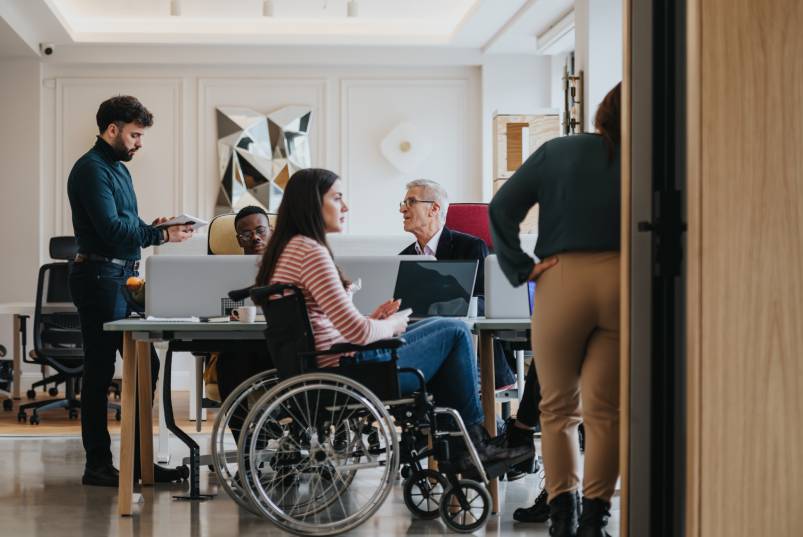A cookie-cutter office design just doesn’t cut it anymore, especially for teams made up of individuals with all kinds of physical needs, cultural backgrounds, and sensory preferences. Designing an inclusive workplace is about crafting an environment where everyone feels welcome, respected, and comfortable enough to do their best work. So, how do you bring to life an office design for a diverse and inclusive workplace? Let’s dive in.
Adjustable and Ergonomic Furniture
Someone who’s 5’2” will likely have very different seating preferences than someone who’s 6’4”. Height differences are just one example of the need for adjustable and ergonomic furniture, and providing such pieces shows that your organization values comfort and usability for everyone.
Adjustable desks are a great solution, allowing employees to customize their workspace to the perfect height. They also let users switch between sitting and standing, improving circulation, reducing fatigue, and keeping them energized throughout the day. A quick stretch of the legs mid-email can make all the difference.
Ergonomic seating is just as essential. Chairs with adjustable armrests, lumbar support, and customizable heights ensure all employees can sit comfortably while maintaining proper posture.
Layout Maneuverability
Cramped layouts might seem like a way to maximize space, but they’re a nightmare for maneuverability. Tight desk configurations and narrow walkways can be incredibly frustrating for employees who use wheelchairs—and let’s face it, even people without mobility concerns hate squeezing past an obstacle course of chairs and desks.
An inclusive office plan ensures that pathways are wide, spaces are easy to maneuver, and tipping over a coworker’s coffee while trying to access the printer is an avoidable risk. Aim for an arrangement that lets everyone flow freely through the space without feeling like they’re participating in an unintentional game of bumper cars.
Comfortable Sensory Experience
Loud noises or bright lights can be downright overwhelming for employees with autism or heightened sensory sensitivities. Inclusive design choices are key here.
Lighting Considerations
Natural lighting is a must-have in any inclusive workplace. Large windows, skylights, and light-diffusing shades can make a world of difference.
Adjustable mood lighting is a fantastic solution for spaces where natural light isn’t an option. Employees can dim or brighten their workspace according to preference.
Controlling Sounds
Some people thrive with a little background buzz, and others need absolute silence to focus. Balancing these needs might sound tricky, but it’s doable with thoughtful office design.
Providing designated areas, such as quiet booths or soundproof rooms, gives those who prefer silence a breather while allowing the chatty teams in the main office to carry on brainstorming. White noise machines, gentle background music, and similar small touches in common areas can help dampen distracting sounds while maintaining a pleasant atmosphere.
Acceptance for Personal Expression
Finally, inclusivity isn’t just about desks or lighting. It’s about people. A diverse team brings together individuals with different cultural backgrounds, beliefs, and lifestyles. Your office design should reflect and celebrate that.
Overlooking the unique needs of each member of a diverse workforce is one of the biggest office layout mistakes you can make. Therefore, an office design for a diverse and inclusive workplace may include personalized wall décor, desk tchotchkes, an open floor plan, and adjustable furniture. Allowing this kind of personalization celebrates diversity and fosters a sense of belonging and respect. A positive and productive environment for everyone requires employers to ensure their employees feel accepted and valued for who they are.

